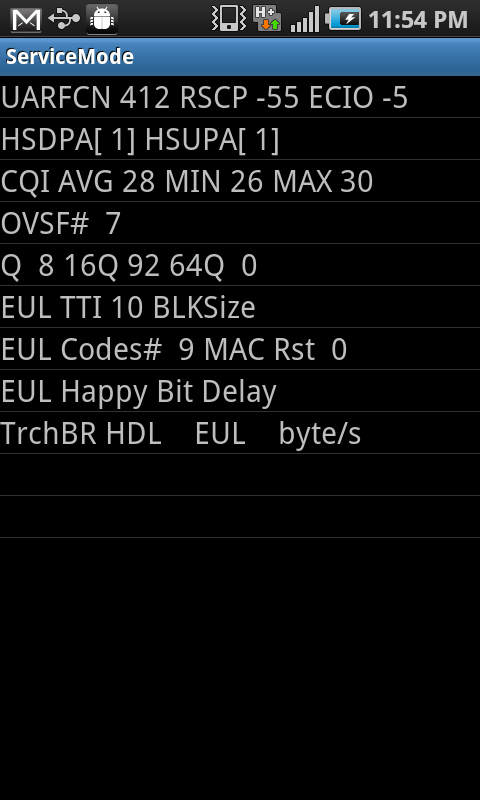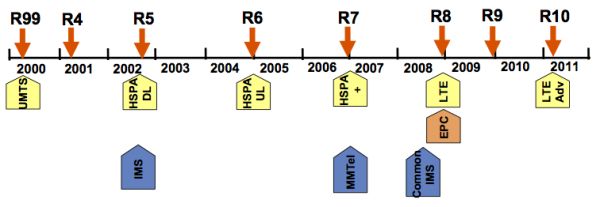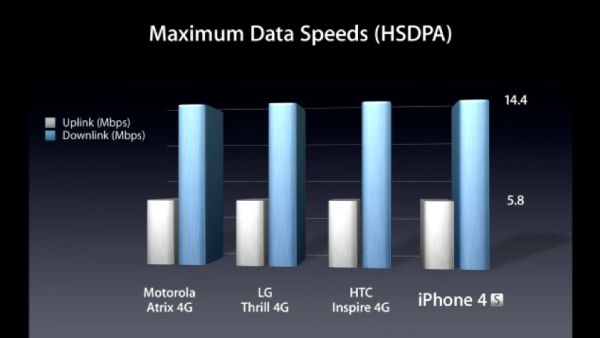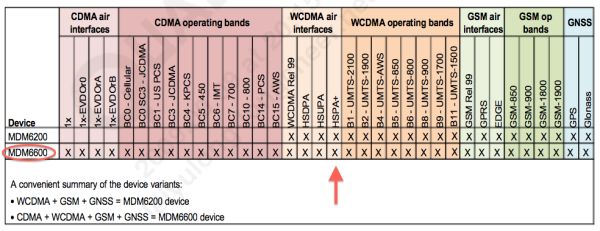The iPhone 4S, HSPA+, and When HSPA+ is Real 4G
by Brian Klug on October 9, 2011 3:30 AM ESTA while after the iPhone 4S announcement, I posted a piece on the iPhone 4S' cellular architecture and talked about the new inclusion of HSPA+ alongside CDMA2000 1x/EVDO and some specifications. Since then, there's been some ongoing confusion about whether the device supports HSPA+, whether it's "4G," and just what all that really means.
It's funny because this issue came up with the HP Veer 4G on AT&T a while back, and with that particular device I did a similar explanatory article in the context of a This Just In post. I wager the somewhat limited cross shopping (and commercial success of the Veer) resulted in many iOS users missing that discussion, and it's cropping up again for the iPhone 4S. The confusion is really twofold. First is a misunderstanding about 3GPP releases and what features are optional or mandatory. Second is a misunderstanding about HSDPA, HSUPA, and modulation coding schemes. Let's break it down.
UMTS standards are defined by an organization known as the 3rd Generation Partnership Project (3GPP), which is a body comprised of partners like telecommunications companies, wireless carriers, and cellular hardware manufacturers. Standards are important, and their formation requires collaboration and discussion. Major revisions are finalized, synchronized, and become "releases." For example the first releases define GSM, release 99 defines UMTS, release 5 defines HSDPA, 6 defines HSUPA, 7 - HSPA+, 8 - LTE, and 10 - LTE Advanced.
This is a huge oversimplification, but you can see how major milestones are bundled up and become releases, and thus when baseband manufacturers like Infineon, Qualcomm, or ST-E release hardware, they're said to be compliant with a given release, and inherit the big features from releases before it.
Where confusion arises is that you don't need to include every feature from some release to say that your hardware is compatible with a given release, and really only features from release 99 are mandatory if you're out to make some UMTS hardware. So when a baseband is "HSPA+" (which really is a colloquial name for the improvements to HSPA made in 3GPP release 7), it doesn't need to include every last feature. Features included in release 7 include things like reduced signaling, faster call setup, continuous packet connectivity, reworked RCC states (idle, DCH, FACH, e.t.c), MIMO, and higher order modulation support. On the downlink, 64QAM or MIMO gets added, and on the uplink, 16QAM gets added.
The confusion in the case of many HSDPA 14.4 (Category 10) devices seems to center on whether it is or isn't HSPA+ if it doesn't include 64QAM support on the downlink (which starts in category 13). This is one of those few times that looking at the Wikipedia table for HSDPA UE categories can be misleading. UE categories with 64QAM are introduced in 3GPP release 7, however it's up to manufacturers to include or not include that feature when actually making hardware. It's interesting to me that all of this misinformation comes up over HSDPA UE category, and somehow HSUPA UE category never gets brought up - I haven't seen anyone claiming that some baseband isn't HSPA+ because it excludes 16QAM on the uplink, yet the overwhelming majority of devices are just using QPSK.
Apple hasn't stated what baseband is in the iPhone 4S (and I guess we won't know absolutely for certain until it gets opened up), but it is almost without doubt MDM6600 just like the Verizon iPhone 4. The specs all line up, and while that part doesn't include 64QAM on the downlink, it does include a number of the other HSPA+ features I've mentioned, and is thus 3GPP Rel.7 and therefore "HSPA+."
Actually using these higher orders of modulation requires favorable radio conditions, of course, and the result is that 64QAM on the downlink or 16QAM on the uplink only gets used in very well tuned systems or cell center. There have been some drive tests done which have shown that 64QAM only really gets used 10% of the time on average. In the iPhone 4S' case here in the USA, it's silly to argue about whether or not the phone can decode 64QAM if AT&T doesn't even use it. A few Samsung devices so far have been based on ST-E's Thor 5730 HSDPA 21.1/Category 14 baseband, and include an engineering menu which shows the percentage of frames encoded using QPSK, 16QAM, or 64QAM.

Note that 64Q is 0. I have run many other tests where 16Q is 100.
I've shown a few other interested people how to see this menu on the Samsung Infuse 4G on AT&T, and thus far none of them has seen any 64QAM frames show up. I've never seen 64QAM pop up either, even with line of sight to the tower in the middle of the night. Those markets include my own in Tucson, AZ, and New York City, which are both AT&T "4G" markets (connoting HSPA+ with improved backhaul) on the coverage viewer. Two data points isn't enough to say conclusively that AT&T isn't using 64QAM, but I haven't seen it yet. You can also see this on video from an Infuse in NYC. Not all AT&T WCDMA "3G" markets are HSPA+, but if you're in a market that AT&T has marked with dark blue (and calls "4G") you can be pretty much assured it's HSPA+.
So the next question is when HSPA+ is and isn't real 4G, and obviously the bar right now is LTE. We've gone over all the real ITU decisions and such in our LTE piece, (whose definition does include DC-HSPA+ and LTE instead of previously just LTE Advanced) but what matters is actual throughput. There's credibility to HSPA+ being comparable to LTE speed as soon as DC-HSPA comes around which aggregates together two 5 MHz WCDMA channels. With all the same features (MIMO, 64QAM, and wider channel bandwidth), DC-HSPA+ gets you approximately to the level of theoretical maximum throughput you can get on LTE. It's easy to see how things are arguably fairly comparable when you consider Verizon uses 10 MHz FDD, and DC-HSPA+ aggregates together two 5 MHz WCDMA channels. Throw in MIMO in addition to just dual-carrier, and maximum theoretical throughput lines up pretty closely as shown in this table by Qualcomm:

That's saying nothing about network latency, however, where LTE will continue to outshine HSPA+. In that case, it does arguably make sense to associate DC-HSPA+ with real LTE and call it real 4G, but until DC-HSPA+ or at least HSPA+ with MIMO it is almost without doubt still 3G. Obviously USA carriers' attempts to pass off HSPA+ 14.4 or even 21.1 as "4G" is immediately laughable marketing, but DC-HSPA+ is arguably real 4G.
Lastly, rumor has it that AT&T and Apple are "working together" to change the 3G status indicator to "4G" for AT&T in the US, a move that would mark the first carrier intrusion into the otherwise completely carrier-untouched iOS. I don't have issue with the status indicators showing H or H+ (for HSPA and HSPA+ when appropriate), but misleading indicators do nobody justice and just serve to reinforce these kinds of misconceptions.













53 Comments
View All Comments
mfenn - Sunday, October 9, 2011 - link
Because 3G is actually 3G?HibyPrime1 - Sunday, October 9, 2011 - link
Thunderbolt - LTEInspire - HSPA+
How are they "essentially the same phone"? You realize you're commenting on an article about cellular technologies, right?
I don't remember who was presenting at the time, but during the iPhone 4S keynote the presenter actually mentioned "we don't want to get into the argument of what is true 4G and what isn't". I can't see them going back on that in matter of days. If "4G" gets put into the AT&T iPhone it will because of AT&T playing the bad guy, not apple.
That's not to say that apple hasn't had their fair share of marketing jibber jabber, something about a server grade hard drive comes to mind.
Pendergast - Monday, October 17, 2011 - link
Again? When did Apple lie?sleepeeg3 - Sunday, October 9, 2011 - link
It is NOT 4G and HSPA+ is half the speeds in the table and LTE is double? The table is assuming dual-MIMO network support, where LTE has quad-MIMO network support, neither of which are guaranteed.The table in this article seems to reflect that, with LTE boasting 4x the theoretical transmission rates:
http://www.radio-electronics.com/info/cellulartele...
This article was needlessly complicated just to explain away the iPhone 4S's 4G deficiency.
If you want a true 4G phone or a Super AMOLED+ screen w/expandibility, buy a Samsung Galaxy S II.
sleepeeg3 - Sunday, October 9, 2011 - link
Edit: Sorry, scratch that last line. Forgot LTE was not shipping to the US on the SGSII, except on Verizon.stationstops - Sunday, October 9, 2011 - link
Here's the thing: whatever HSPA+ is supposed to be able to deliver in terms of speeds beyond 3G, AT&T's implementation just 'doesn't'.I have an AT&T Infuse 4G (my company pays for it)...I've never seen it get faster rates than my AT&T iPhone 4 (my phone) - side by side, whereever I am, they have the exact same speed (infuse is actually slower half the time).
I've looked around for reviews on the web, and haven't found anyone getting anything but plain vanilla 3G speeds with HSPA+ on AT&T (I *have* seen reviews with much better speeds on HSPA+ on T-Mobile).
I get the feeling that AT&T upgraded a network segment which wasn't the bottleneck, like upgrading your wifi from 802.11b to 802.11n when your backhaul is 1.5 Mbps DSL.
Brian Klug - Sunday, October 9, 2011 - link
It does depend on the backhaul of the tower serving you, so that part is correct, however there is a dramatic difference between the iPhone 4 (HSDPA 7.2) and other newer devices with HSDPA 14.4 or 21.1. In the case of the Infuse for example, I can get 9-10 Mbps (pre the latest update, which I won't get into...), whereas the iPhone 4 is literally at the limits of X-Gold 618 with 6.1 Mbps. We'll go into this at more length in that device's review.-Brian
fancarolina - Monday, October 10, 2011 - link
I like the information covered in this article. I would like to see an expanded generic article covering all current "4G" technologies. A comparison of HSPA+, LTE, and WiMax and it would be helpful to also include future technologies like Sprints LTE, is it different then Verizons LTE implementation.If this has already been written please post a link to it.
iwod - Monday, October 10, 2011 - link
I was going to ask about the HSPA+ thing soon after the introduction of 4S, but got distracted and saddened by the lost of Steve Jobs. Again, R.I.P.I was and had always under the impression HSPA+ start at 21Mb/s, and it has to support All IP Network. Since we moved to 3G too early in the early 20s and everyone had gotten used to crappy 3G services, i can understand the frustration and renaming of 4G. All IP Network and 21Mb/s was enough for a break until we get LTE Advanced where we start calling 100Mb/s Mobile Network 5G. At least, i think that is there plan.
However you are now telling me All IP, 21Mb/Mbs, and all other quality assurance and improvement in HSPA+ are OPTIONAL!!!.
My God isn't this like selling a Ferrari and then realize every parts inside are actually Toyota, and all the advertised speed and engine and things are optional extra?
Then there is 4G LTE, which last time i heard doesn't even have a standard for voice yet and are currently using Fall back to UMTS for Voice Signal.
No Wonder why Intel / WiMax wanted to change the Industry, No Wonder why apple wanted to control more of it. What a pile of disgusting mess.
jhh - Monday, October 10, 2011 - link
As shown in the diagram at the top of the article, LTE does have a common voice standard, it's Common IMS (IP Multimedia Subsystem). Carriers have not yet widely deployed and enabled IMS in their networks at this time. Handoffs between IMS over LTE and 3G services are complicated, which is one reason this is not in production use. Both the carrier and the handset have to support both modes, and work well before a carrier will deploy it. In the US, things are more complicated by having different underlying fallbacks, namely CDMA and UMTS/GSM. Add in complications related to roaming between carriers, and its a tough nut to crack. But, IMS is the future of wireless voice service from carriers as LTE deployments continue. Verizon has expectations to deploy IMS-based volce over LTE sometime in 2012.There was some effort to use VoLGA (Voice over LTE Generic Access) rather than IMS by Deutsche Telecom as an interim measure, but this effort seems to have stopped. This was the only other viable option for Voice over LTE, other than over-the-top protocols like Skype.